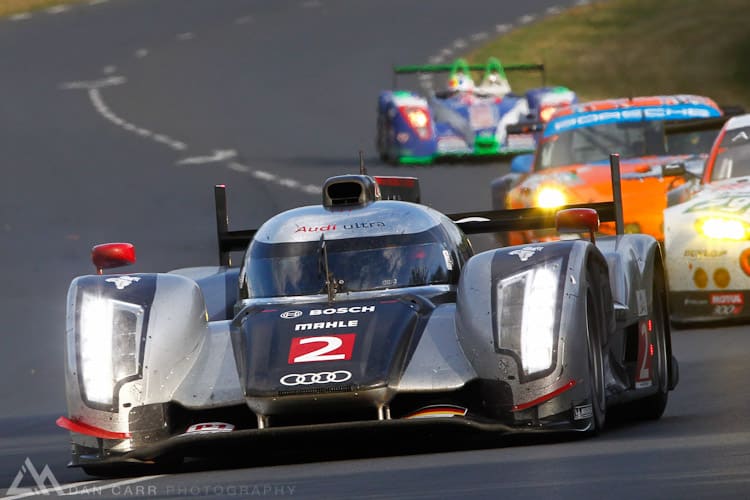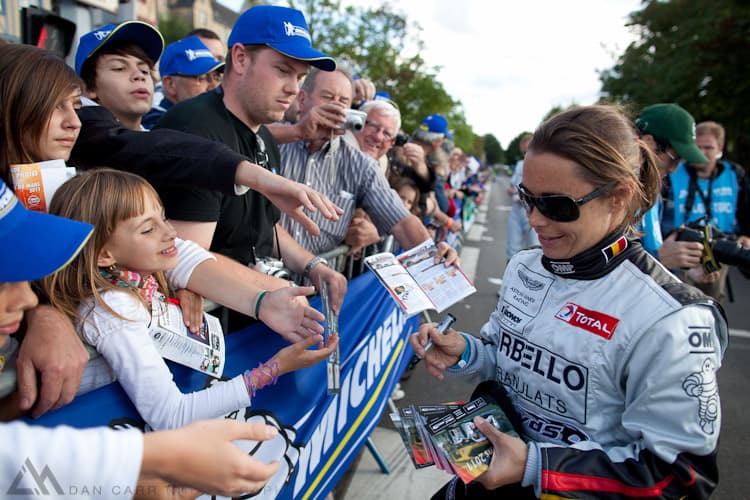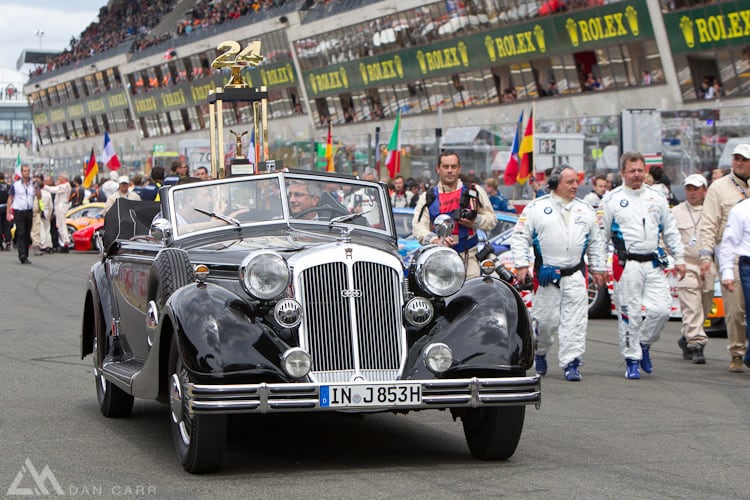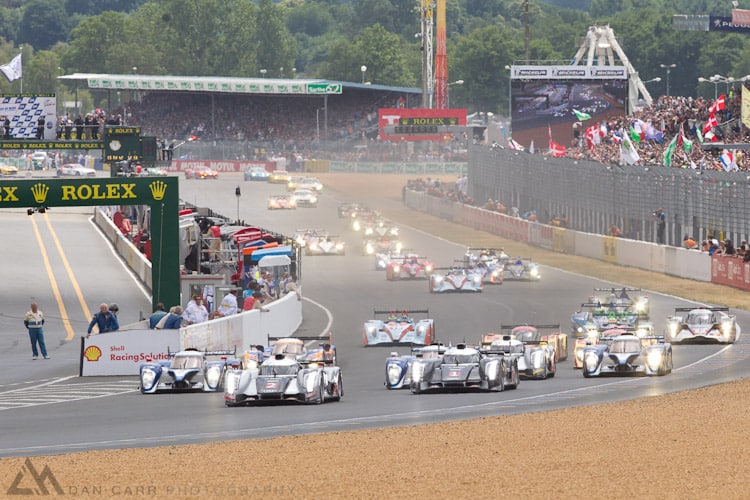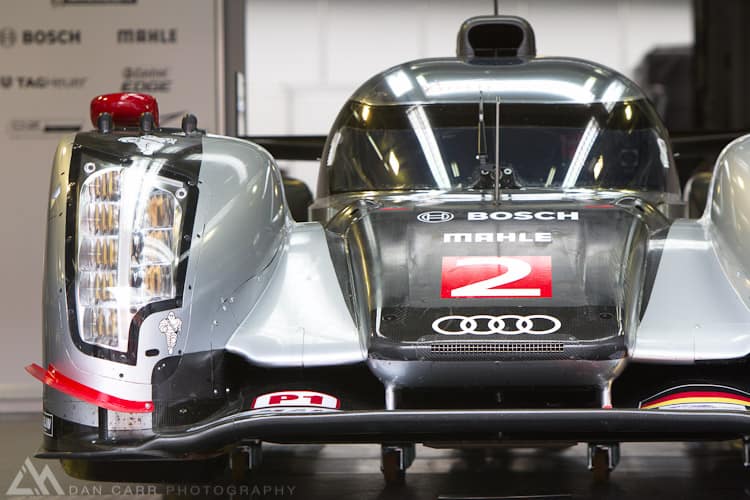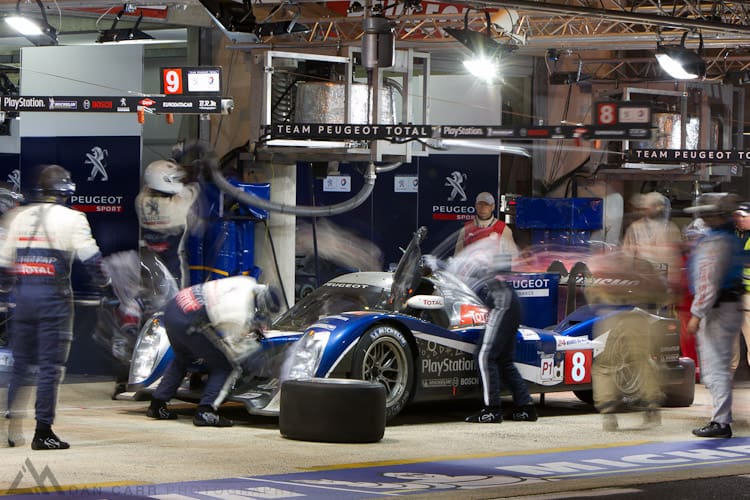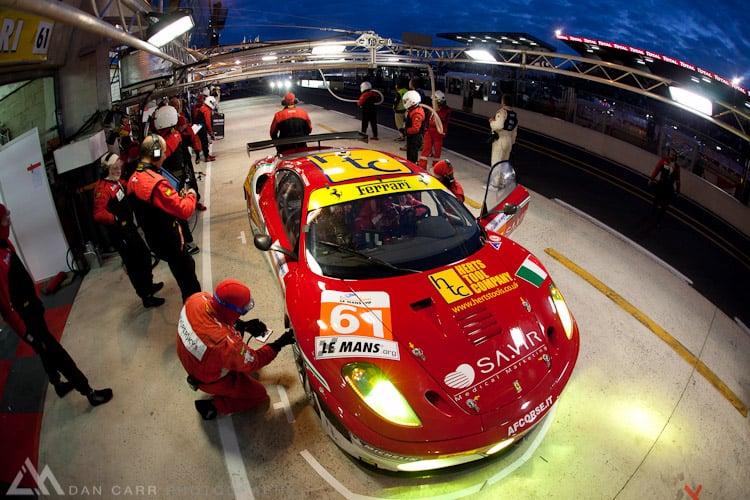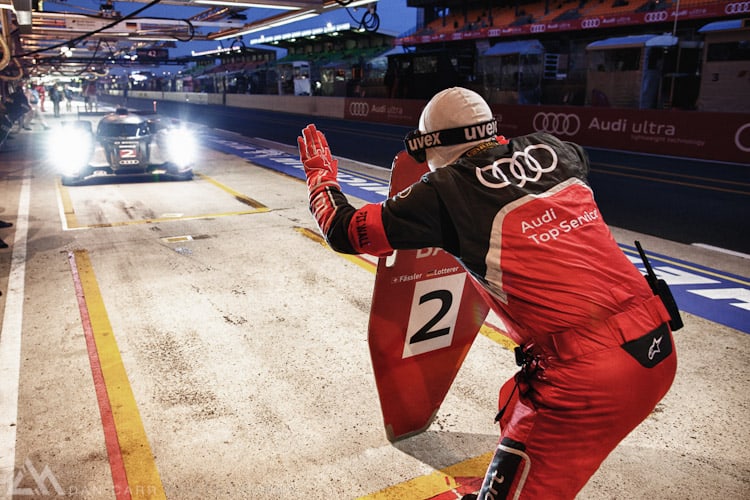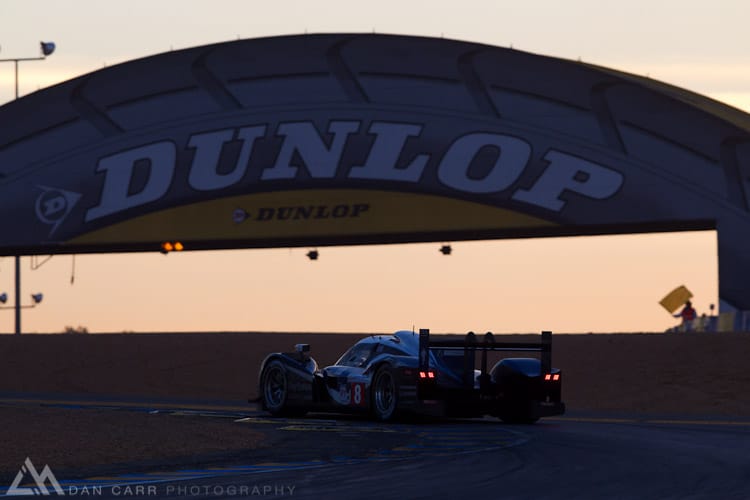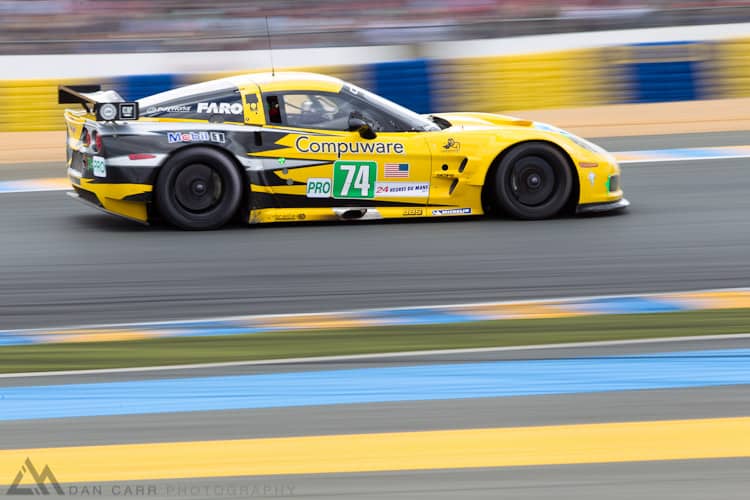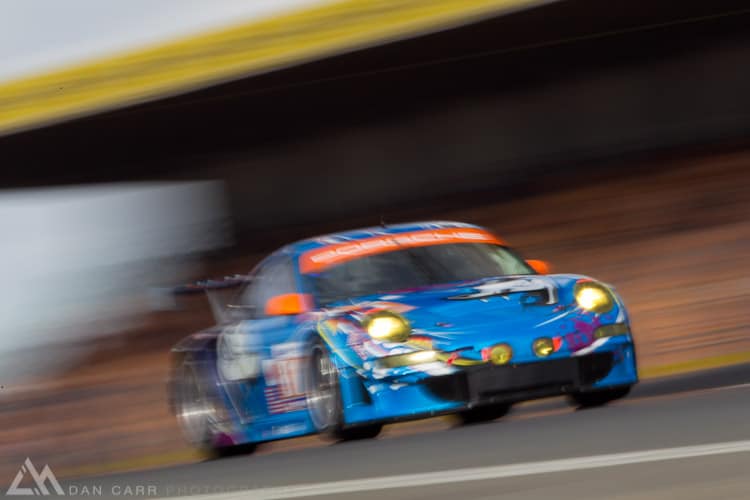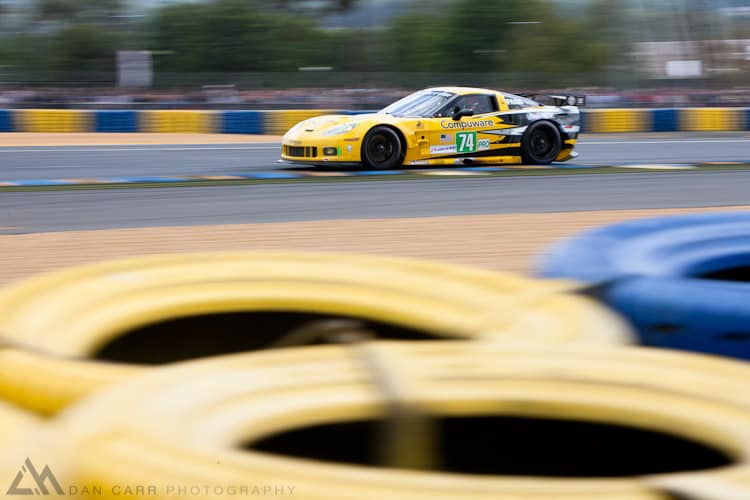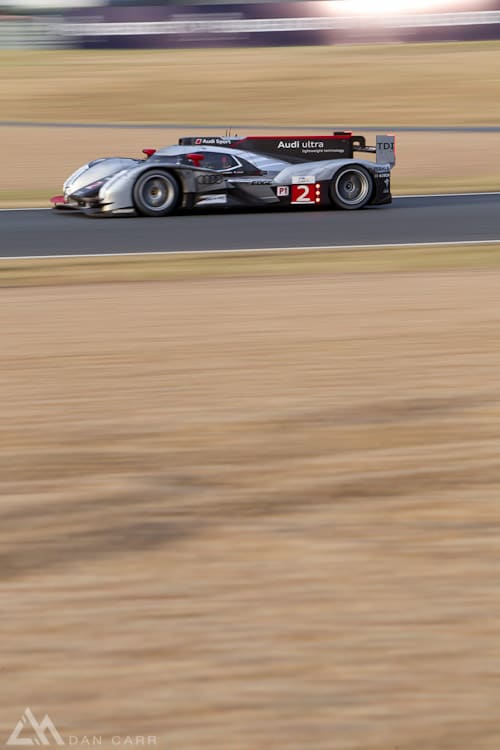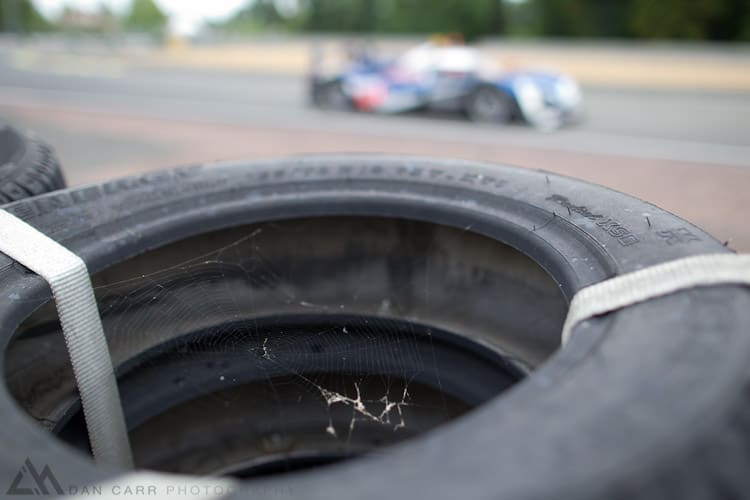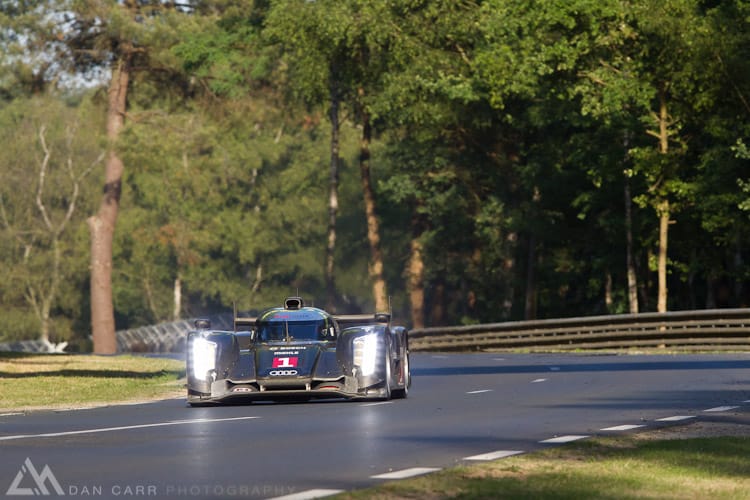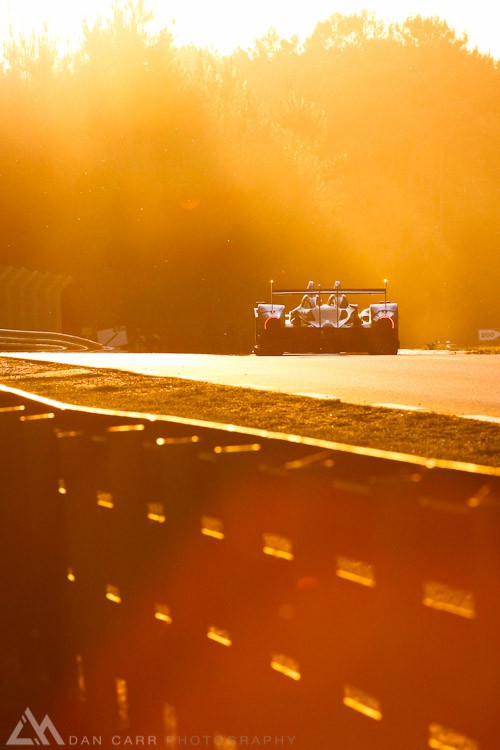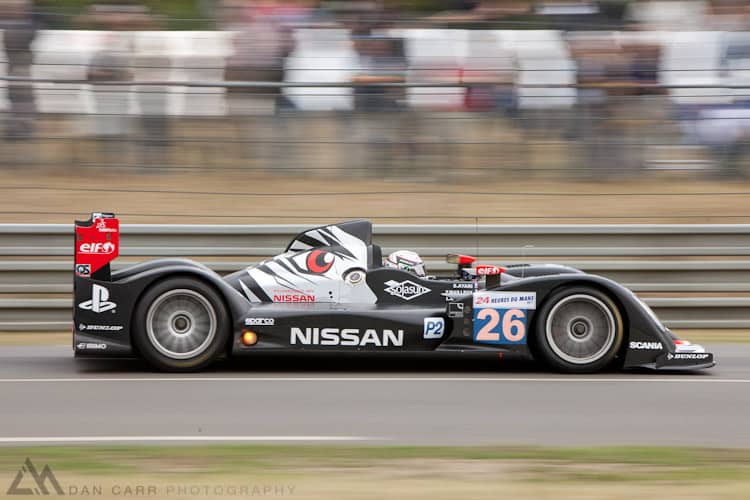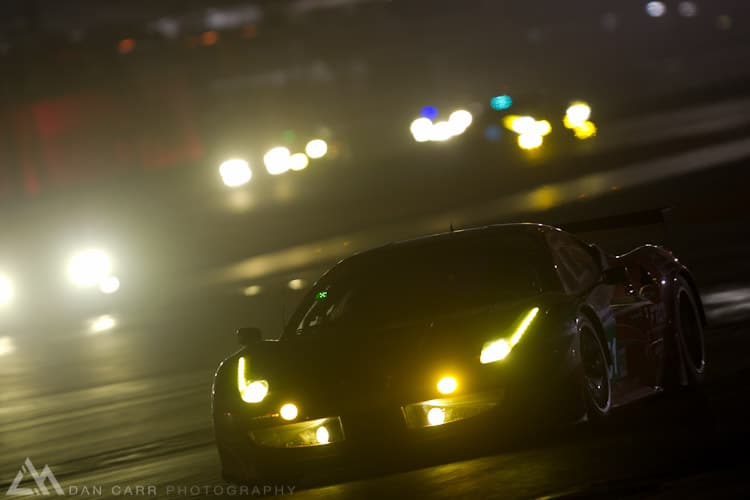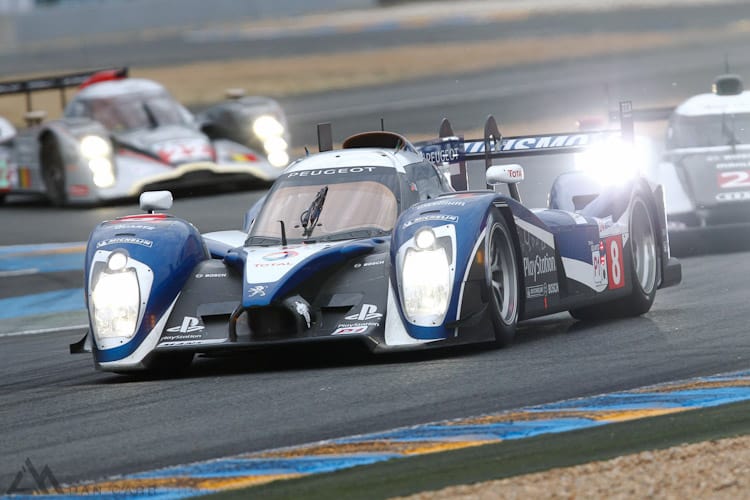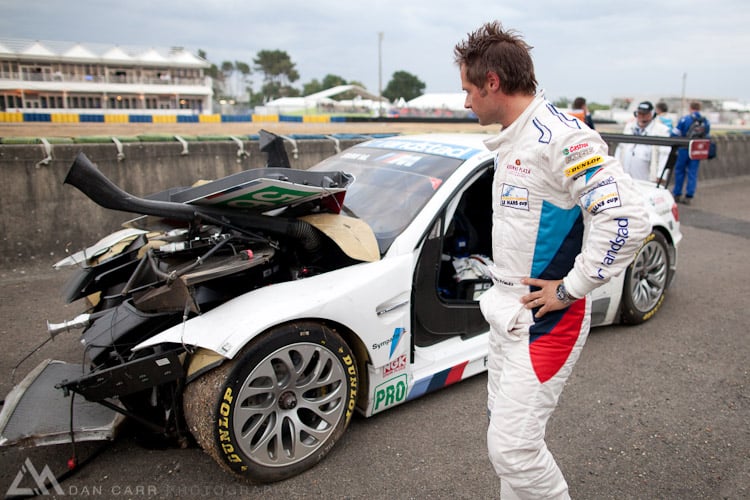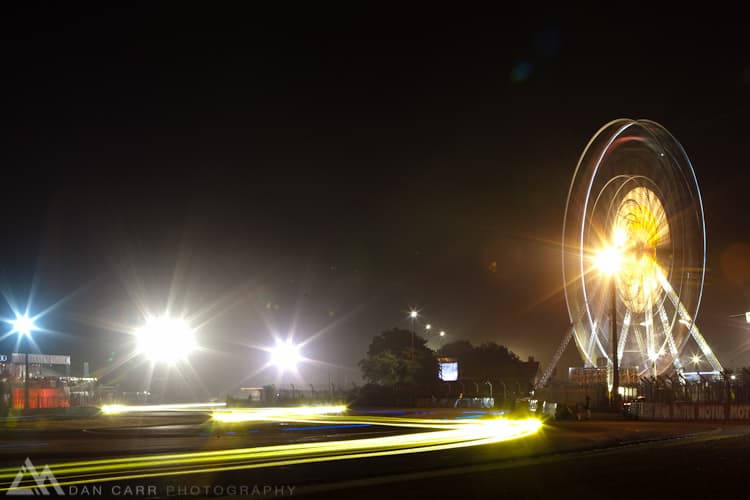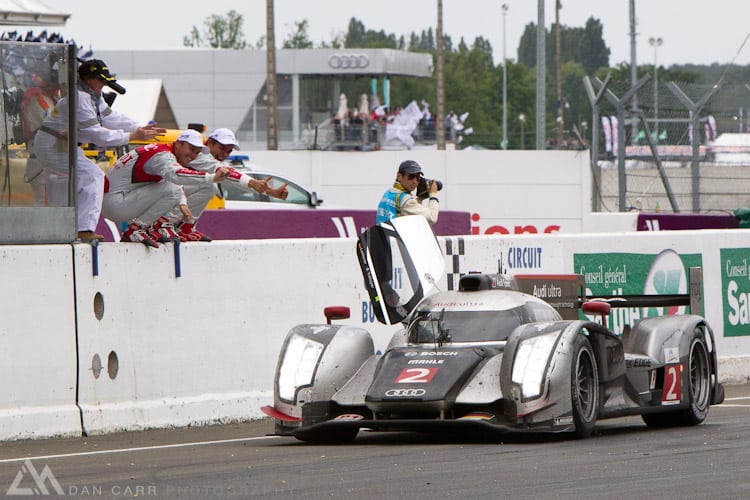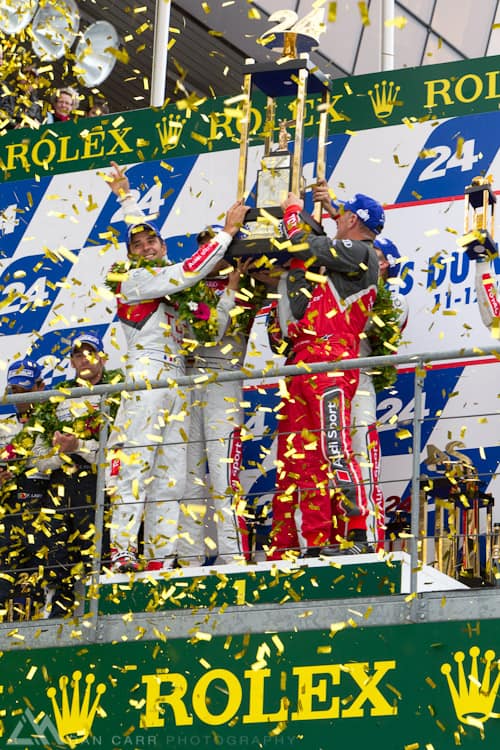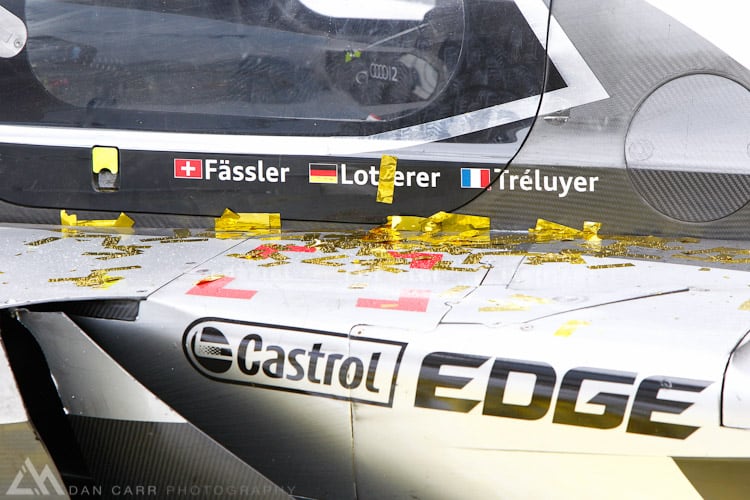In June 2011 I got to fulfill a lifelong ambition and head to France to shoot the worlds greatest motor race, the 24 hours of Le Mans. I’ve followed many forms of motorsports since I was young and before I discovered photography I was all set to work in the industry with an engineering degree. Having attended the race at Le Mans in a spectating capacity several times I’ve always wanted to be on the other side of the fence with my camera and 2011 was my opportunity. This race is unlike any other that I have ever been to though, apart from the obvious fact that it’s 24 hours long there is a uniqueness to the festivities and atmosphere that spread throughout the fans and the circuit during the 5 day run up to the actual race. Those who have attended the event often return year after year, making the pilgrimage from all corners of the globe and in total the track plays host to a quarter of a million fans during the middle of June. For me this was an opportunity not to be wasted because getting credentialed for such high profile events is not an every day occurrence. I’d love to incorporate more motorsport shooting into my work and this was going to be a prime place to show people what I was capable of.
Click through for a huge post and some videos on the whole experience.
What gear did I take with me ?
I know people love to know what equipment was used so I prepared a short video when I was packing. I’ll talk a little bit about what worked and what didn’t later on.
My biggest concern before I left was which long lens was going to be the right choice. I asked several guys who have shot there before and I had a really mixed bag of responses. Some said a 300mm f2.8 and some teleconverters works well and some swore by the 500mm f4. In the end I decided to take my trusty 300mm f2.8 L IS with me for a couple of reasons. Firstly I figured that f2.8 would be nice to have at dusk and dawn and even in the middle of the night. Secondly I had just taken delivery of both of Canon’s latest MKIII teleconverters and I was eager to test them out. I’ve experienced a fair bit of success shooting with the 300 and the previous MKII TCs so it would be an interesting test. I still packed the older MKIIs in my bag as well though as they were a trusted component and if I experienced any issues with the newer ones I would have those to fall back on. So what was the eventual outcome of this decision you might be asking ? Well I wasn’t disappointed for a second. By far the most popular choice of lens there amongst other shooters was the 500mm. The shooting positions at Le Mans are close enough to the track that a 600mm is not really necessary. I found several angles where the 300mm was absolutely the best choice of lens for the job. In some circumstances I was a little short on length but this didn’t happen enough for me to be worried I had the wrong gear with me. The absolute best setup would be both a 300 and a 500 at this track though that would be hard work for such a long event. I routinely used the 1.4x MKIII extender on the 300mm and was very pleased with the sharpness although quickly learned that the AF speed suffered hugely in diminishing lighting. The 2x MKIII >extender also produced sharp shots but my keeper rate was low with that as the AF speed was simply too slow to lock onto subjects moving as fast as these cars were. Using a 300 and 1.4x on my Canon 1dMK4 gave me a 35mm equivalent of 546mm f4 and it worked great when I needed it.
My general setup for the week was a 70-200 f2.8 L IS on a Canon 5dMKII over one shoulder and the 300mm on my 1dMK4 on a monopod on my other shoulder. I carried my 24mm f1.4 and extenders along with batteries and memory cards in a Think Tank Skin Set which I have reviewed before on this site. I love the Skin components from these guys because they take up very little room in your bag when you are traveling. On the flight over to France I put all the lenses and camera bodies into a Think Tank Airport Airstream roller bag with an Airport Check In shoulder bag holding all my computer accessories. Incidentally my laptop setup was my usual combo of Macbook Pro 15″ and a couple of LaCie Rugged drives to backup photos onto.
I picked up a new shoulder pad for my monopod just prior to the trip, the Aquatech wrap (which I reviewed here) was great to have for an event like this where I was carrying a long lens on my shoulder for hours and hours each day. Before the trip I wasn’t sure which wide angle lens to take with me either. I ended up packing both the 17-40 and the 24mm f2.4 mkII just in case. The 24mm is my absolute favorite lens that I own. It’s images are so crisp and so full of contrast that I’ve never once regretted the rather large price tag that it comes with. In the end I used the 24mm exclusively all week. For night work in the pit lane it proved to be the perfect focal length on a full frame body like my 5dMKII for shots of the cars re-fueling. On a 1.3 crop body it would not have been wide enough so for pit lane work I used the 24mm on a 5dMK2 and a 70-200 on the 1dMK4. The wider aperture of the 24mm prime was also appreciated in the dark. Occasionally I would throw a 15mm fisheye on the 5d as well. Next time I would not hesitate to just leave the 17-40 at home though, I love to use primes whenever I can because it forces you to think about your composition much more than you do with a zoom.
On to the track
Some of my favorite images are shown below with a bit of a commentary on them and where they were shot. If you’d like to take a look at a full gallery of shots then please head over here.
The La Sarthe circuit is unlike any other in that it expands out onto public roads and doesn’t return back to the pit lane again for nearly 9 miles. This makes covering the track, photographically speaking, quite a challenge. Some of the corners are a very long way from the media center and require intricate knowledge of the surrounding French countryside and a maze or restricted forest tracks to access them. Due to the scale of it all there are also very distinct differences in the light at various locations during different times of day. As with all photography, light is key, so you must pay attention to it’s position in the sky and the compass direction that the track faces. With a bit of careful consideration it’s possible to work out an optimal time to be at every corner on this huge track. Throughout the practice and qualifying I gathered info and gradually made a plan for the race so I knew where I wanted to be for every hour of it. I have to say a HUGE thanks to fellow shooters Dave Davis and Bob Chapman for their invaluable advice during the week. These guys have been shooting the race for many years and without them I would not have come away with so many images to be proud of.
Some terrible quality GoPro footage….
The Start
Using GoPro camera on top of my lens I captured what it was like to shoot the start of the race. This was hands down one of the most exciting things I have ever shot. I was terrified of blowing the start shot but in the end it worked well. I shot with the 300mm and it was perfect. Due to the temperature of the track there was a lot of heat haze. Telephoto lenses compress the haze and you get very soft looking images if you are shooting too long. I think for the start the 300 was the best choice and those with 500 and 600mm lenses probably suffered with the heat haze if they were shooting from a low angle.
The pit lane
Dodging cars in the pit lane took a little getting used to. There seemed to be a plethora of unwritten rules as to where you could walk and stand and it was only through trial and error that I figured it out during the night time practice sessions during the week. I was glad I spent the time there though so when the race came I was much more comfortable with running up and down there. I knew the shots I wanted and I already had several things planned out for the race. It was also important to know where the pit box was for each car, and then pay attention to the radio to know who was coming into pit at what time. This way I could run to the correct pit box before the car got there, to try and get a good shooting position. Incidentally, fireproof overalls are mandatory in the pit lane and yes they get bloody hot when you are running about carrying a ton of gear!
I love this shot of Sebastian Bourdais sitting in his car. The front of the Peugeot is so curvy that I decided to put the fisheye lens right up to the car and itreally accentuates the car’s design. You can still see the driver in the car and also the pit board above the box to let you know which car it is.
When the driver of the Audi #2 got pole position for Le Mans there was a huge media scrum to get a photo of him getting out of the car. Instead of joining the scrum I went on the other side and slowed my shutter speed down to try and catch the flashes from the other photographers. I managed to grab a couple of flashes, I wish there had been a couple more but I still quite like how this turned out. I think this tells a good story and I was able to get the Audi #2 banner in the background and see the car much better than I would have done if I was just trying to get a shot of just the driver.
In the middle of the night during the race I grabbed my tripod and a cable release to do a few long exposures of the pit stops. Listening to the radio commentary I could tell who was coming into the pit lane and position myself opposite them on the pit wall.
Occasionally I grabbed my monopod and a cable release. With the 5d2 and 15mm fisheye I could raise the camera up high on the monopod and fire it using the cable release to achieve a more interesting shooting angle. I like this shot below as it takes int he dusk sky and the pitlane grandstands in the background.
Dawn is coming as the leading Audi comes into the pit lane. I waited about half an hour to get this shot and that meant I was running a little late to get to Dunlop Bridge for sunrise. I literally had to sprint to the media center, rip off my fireproof overalls and then run full speed up the inside of the track as the sun came up.
Dunlop chicane
There’s few things in motor racing that are as iconic as the Dunlop Bridge at La Sarthe. The Chicane just before it has several great shooting positions. A quick walk from the pit lane allows you to shoot from behind the cars as the enter the first apex of the chicane. Just before sunrise there was yellow flag and I was able to capture the silhouette below of the Peugeot with a marshal waving a flag in the background.
Moving up the track a little further there are some excellent colors painted on the ground so I spent some time shooting panning shots at low shutter speeds to capture this shot of the Corvette. Shooting at 1/30th , 1/40th , 1/60th of a second is quite difficult but over the week I found myself getting much more proficient at it. This was shot with my 300mm lens, the perfect length for this shot.
Moving another 50 yards up the inside of the track you can get a nice shot of the cars exiting the chicane and running under the bridge. The sun hits this part of the track just after sunrise so this is the best time to shoot here. I shot on the inside of the track during the Saturday morning warmup session to get this shot of the Porsche.
I also shot from the outside of the track with my 70-200 to get this shot. It’d another slow pan but I noticed the correlation of the car’s colors and the tire barriers. Crouching down low and shooting wider on the 70-200 I was able to keep the barrier in the shot and still blur everything in the shot except the car.
During the race I literally sprinted from the pit lane at sunrise over the bridge to the outside of the track. Here you get a brilliant shot as the sun crests the horizon and hits the drivers right in the eyes. It brings out a lot of texture and detail on the dirty, battle damaged cars. Once again the light on the Sunday morning was simply beautiful. At sunrise you definitely want to shoot this part of the track or a little further down on the run in to Tetre Rouge. By the time I shot this angle at sunrise during the race I was exhausted and been awake for 24 hours. The exhilaration of capturing the cars in such perfect light was keeping me going though. I knew I had to stick to my race plan to cover the rest of the track! Thankfully I was able to grab a chocolate covered waffle at this point for a sugar boost!
The Esses
This was the scene of Allan McNish’s enormous accident in the first hour of the race after coming under the Dunlop Bridge. At the time I was standing right next to the bridge though I was looking the other direction and missed the actual accident. As soon as I realized what happened I ran down to the scene though and was able to capture a few shots of Allan’s car as they removed it from the gravel trap.
The following morning I returned to the Esses after sunrise after shooting at Dunlop. It’s a nice place to get a few slow shutter speed panning shots and I liked how this shot of the winning Audi turned out. When I’m shooting slow pans I’m always on the lookout for foreground and background elements to blur out. To me there’s little point shooting a super slow shutter pan and being tight on the car. You need that blurred surrounding to appreciate the speed.
A little further down the track gets you to the second part of the Esses where you can either shoot low, directly at the cars, or from a slightly higher raised platform. The low position is a real eye opener as the cars come screaming out of the corner just a few feet away from you. Breathtaking stuff. For this shot, a 300mm on a 1 series body is perfect. If you take the higher raised shooting position then a 500mm is perfect. Getting low with the 300 though , and having the low sun at dawn gives a glint in the driver’s eyes that you always want to strive for.
Tetre Rouge
Strictly speaking the shot below if on the run down to Tetre Rouge. Again this gets the best light in the morning and you can shoot with any length from 300 to 600mm depending on how far down you walk. I only shot here for a couple of minutes on Sunday morning though, not enough time to walk a bit further and get a shot of them exiting the corner onto the Mulsanne straight. I’ll have to get that one next year.
Playstation Chicane
The first of the two chicanes on the Mulsanne straight is accessible with one of the media navettes. I only went there the one time on Sunday lunchtime and it’s not my favorite part of the track though I made a few cool images there. I didn’t like the head on shot so I shot them from behind, and also found a pretty neat looking spider web in one of the tire barriers which I incorporated into a couple of cool shots.
Mulsanne Corner
Being on the outside of the far corner of the circuit this is time consuming to get to and there is no media shuttle to get you there. After talking to a few regular photogs I decided not to bother going down there during the week.
No man’s land
The run out of Mulsanne corner and down to Indianapolis doesn’t really have a name. There is no way for spectators to get anywhere near this area and getting there as a photographer requires some prior knowledge of a series of woodland tracks, and the use of a moped. I caught a ride there with Bob Chapman on the Saturday evening. If you get nice light as the sun goes down, this is the best pace on the track to shoot. As it happens, we had some stunning conditions for the hour we spent there. It was an hour of shooting that I will never forget for my whole career. The sun pokes in and out between trees as it goes down, bathing the cars is a very directional soft warm light. Shooting towards the sun gives you an incredibly orange sky and reflections off the track. It really is a beautiful part of the track as the cars pass through the woodland at 180mph+
The last few seconds of sunlight were out of this world!!
Indianapolis
There’s a couple of shooting spots for this cambered corner. You can shoot the cars head on coming into it but I found the background to be too dull for my liking. You can also walk down the track a little further and shoot them coming out of the corner and passing just a couple of feet from you to head to Arnage. I lined up the Audi sign in the background and then waited for an Audi to come round the corner.
Arnage
Just 50 feet further on you have the tight slow Arnage corner. From the inside of the track I didn’t really like the shot of them going through the corner because there was too much clutter in the background. There is a good place for some slow shutter pans though as the cars come into the breaking zone with all the spectators in the background.
Porsche Curves
The photo position on the entry to the Porsche curves is incredibly close to the track. Literally a couple of feet away from the tarmac. You can shoot here with 300mm although 500mm is preferable here. It gets excellent evening light and as the sun gets low in the sky you begin to see it glint onto the drivers face as the cars pass through pockets of sunlight caused by the surrounding trees.
I tested the new MKII 1.4x teleconverter a lot at this location and it proved to be very good at locking onto the cars coming at me at about 160-180mph.
If you take a walk further down the track you can cross over the run-off area and climb onto the banking that overlooks the apex of the first curve for a decent panning shot. There’s a couple of other shots at this location but you need a 500mm or even longer to get them effectively.
Ford Chicane
The Ford Chicane is an easy place to get to from the media center so I ended up there a few times. There are several photo holes in the fencing and I found that they each required a different lens for the optimal shot. My 300mm was ok for a panning shot of them exiting the final part of the chicane but I needed to shoot longer to get the head on shots of them crossing the second apex. The first apex was out of my reach with my setup. It is also possible to get to the entry of the first part of the chicane if you travel to the inside of the circuit. I shot there for half an hour just after sundown but it wasn’t my favorite spot on the track.
During qualifying Any Prilaux crashed his BMW heavily coming into the chicane and I managed to grab a few shots of him surveying the damage.
Pit straight
A short walk past the Ford Chicane gets you to the pit straight where you can shoot back at the cars exiting the ford chicane with the fair ground rides in the background and the grandstand.
The finish line
The midday backlit light on the finish line is about as bad as you can think of. I shot from the wall opposite the pits to get the famous Rolex clock in the shot with the winning car and the checkered flag. It’s a bit of a dull shot though to be honest but when the car came back around I spotted the two team mates of the winning car on the wall and got a nice shot of them celebrating as their car opened the door having passed the line.
The Podium
Having shot the finish line it was a mad dash with all the other photographers to the other side of the track to get a good position for the podium. There was a coral directly underneath it but I could not find a way into it. The typical shot most people try and get is standing quite a long way back with a long telephoto lens but I wanted to get close to the winning car. I shot from below and to the right of the podium and it worked out pretty well giving a nice view of the winner and the trophies. I also got a few closeup shots of the winning car with the 24 Heures Du Mans signage in the background. This was much harder to get because I was shooting through gaps between many people. I tried probably 100 shots to get these and most of them had someone’s arm or head in them. I love to see the dirt and the ticker tape on the car though. The sign in the back is important to tell the story!

